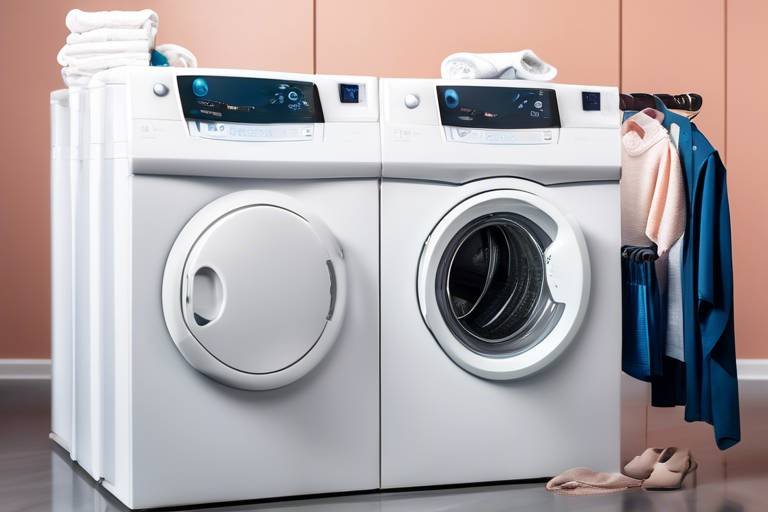How to Use Gadgets to Monitor Your Indoor Air Quality
Indoor air quality is a crucial aspect of our daily lives that often goes unnoticed. The air we breathe in our homes or offices can have a significant impact on our health and well-being. Fortunately, advancements in technology have made it easier than ever to monitor and improve indoor air quality using a variety of gadgets.
One of the key tools in monitoring indoor air quality is the air quality monitor. These devices come in various forms, from basic models that measure common pollutants like dust and allergens to more advanced sensors that can detect volatile organic compounds (VOCs) and other harmful substances in the air.
Smart thermostats, typically known for regulating temperature, have also evolved to include features that monitor humidity levels and air quality. By providing insights and recommendations, these smart thermostats contribute to creating a healthier indoor environment for occupants.
Air purifiers play a significant role in improving indoor air quality by filtering out contaminants such as dust, pollen, pet dander, and even odors. These devices help reduce the risk of respiratory issues and create a cleaner and fresher atmosphere indoors.
Humidity sensors are essential gadgets for maintaining optimal moisture levels in indoor spaces. By preventing mold growth and ensuring a comfortable living environment, humidity sensors contribute to overall indoor air quality.
Carbon monoxide detectors are critical for safety as they can detect this deadly gas, which is odorless and potentially fatal in high concentrations. Integrating these detectors into your indoor air quality monitoring system is crucial for ensuring a safe living environment.
These air quality monitoring gadgets can be seamlessly integrated with smart home systems, enabling automation and remote monitoring capabilities. This integration allows users to monitor indoor air quality from anywhere and take necessary actions to maintain a healthy environment.
By analyzing the data collected by these gadgets, users can gain valuable insights and receive recommendations for improving indoor air quality. This data-driven approach can lead to a healthier living environment, better sleep quality, increased productivity, and overall well-being for individuals and their families.

Air Quality Monitors
Air quality monitors are essential gadgets that can provide valuable insights into the air you breathe indoors. These devices come in various types, ranging from basic models to advanced sensors that can detect a wide range of pollutants present in the air. By using air quality monitors, you can track the levels of pollutants such as dust, pollen, volatile organic compounds (VOCs), and more, allowing you to take necessary actions to improve the air quality within your living or working space.
One of the key benefits of air quality monitors is their ability to alert you to potential issues with indoor air quality before they become a significant concern. By continuously monitoring the air in your home or office, these gadgets can help you identify sources of pollution, track trends in air quality over time, and make informed decisions to create a healthier environment for yourself and your family.
Additionally, some advanced air quality monitors can provide real-time data on air quality parameters, such as particulate matter levels, humidity, temperature, and carbon dioxide levels. This data can be crucial in understanding the factors that affect indoor air quality and optimizing your living or working conditions for better health and well-being.
Furthermore, air quality monitors can be integrated with smart home systems, allowing you to access and control the data remotely through your smartphone or other devices. This seamless integration enables you to monitor and manage indoor air quality efficiently, even when you are away from home, ensuring a safe and comfortable environment at all times.

Smart Thermostats
Smart thermostats are not just your average temperature regulators; they are like the brain of your HVAC system. These intelligent devices go beyond simply adjusting the temperature in your home; they also keep an eye on humidity levels and air quality. By constantly monitoring these factors, smart thermostats provide valuable insights and recommendations to create a healthier indoor environment for you and your family.

Air Purifiers
When it comes to maintaining clean and healthy indoor air quality, play a crucial role in filtering out contaminants and improving the overall atmosphere in your home or office. These innovative gadgets are designed to remove harmful particles such as dust, pollen, pet dander, and even odors, creating a fresher and healthier environment for you and your loved ones.
Using advanced filtration systems, can effectively capture and neutralize airborne pollutants, helping to reduce the risk of respiratory issues and allergies. By constantly circulating and purifying the air, these devices contribute to a cleaner living space and can provide relief for individuals sensitive to airborne irritants.
One of the key benefits of is their ability to target specific pollutants, ensuring that you breathe in clean and purified air. Whether you are concerned about allergens, smoke, or other airborne particles, these gadgets are equipped to tackle a variety of indoor air pollutants, promoting a healthier indoor environment.
Additionally, can be particularly beneficial for individuals with respiratory conditions such as asthma or allergies, as they help to reduce the presence of triggers that can exacerbate symptoms. By investing in an air purifier, you can create a safer and more comfortable living space that promotes better respiratory health and overall well-being.

Humidity Sensors
Humidity sensors play a crucial role in maintaining a healthy indoor environment by monitoring and controlling moisture levels. These sensors measure the amount of water vapor in the air, helping you prevent issues such as mold growth and dampness. By detecting high humidity levels, humidity sensors alert you to take necessary actions to reduce moisture, ensuring a comfortable and safe living space.
Humidity sensors are especially beneficial in areas prone to high humidity, such as bathrooms and basements, where excess moisture can lead to mold and mildew. By integrating humidity sensors into your smart home system, you can automate the operation of dehumidifiers or ventilation systems to maintain optimal humidity levels, improving air quality and overall comfort.
Furthermore, humidity sensors can also help you save energy by optimizing the performance of your HVAC system. By adjusting humidity levels based on real-time data from the sensors, you can prevent overworking your heating or cooling system, leading to lower energy bills and increased efficiency.
Overall, humidity sensors are essential gadgets for monitoring and controlling moisture levels in your indoor environment, contributing to a healthier and more comfortable living space for you and your family.

Carbon Monoxide Detectors
Carbon monoxide detectors are essential devices that play a crucial role in ensuring indoor air safety. These detectors are designed to alert occupants to the presence of carbon monoxide, a colorless, odorless gas that can be deadly in high concentrations. By continuously monitoring the air for carbon monoxide levels, these detectors provide early warnings in case of a leak from gas appliances, fireplaces, or other sources.
Carbon monoxide detectors typically use sensors to detect the gas and trigger an alarm if levels exceed safe limits. These alarms are loud and distinctive, ensuring that occupants are alerted even while sleeping. It is recommended to install carbon monoxide detectors in key areas of the home, such as near bedrooms and common living spaces, to provide comprehensive coverage.
In addition to standalone carbon monoxide detectors, there are also combination detectors available that can monitor both smoke and carbon monoxide levels. This dual functionality provides added safety and convenience for homeowners, as it eliminates the need for multiple devices.
Regular maintenance and testing of carbon monoxide detectors are essential to ensure their proper functioning. It is recommended to test the detectors monthly, replace batteries as needed, and replace the entire unit according to the manufacturer's guidelines to guarantee continued protection against carbon monoxide exposure.

Integration with Smart Home Systems
Integration with Smart Home Systems allows for a seamless connection between your air quality monitoring gadgets and the rest of your smart home devices. By integrating these gadgets, you can create a more efficient and convenient system for monitoring and controlling the air quality in your home. This integration enables you to receive real-time alerts and updates on the air quality status through your smart home hub or mobile device.
One of the key benefits of integrating air quality monitoring gadgets with smart home systems is the ability to automate actions based on the data collected. For example, if the air quality sensor detects high levels of pollutants, the system can automatically turn on the air purifier or adjust the ventilation system to improve air quality. This level of automation not only enhances convenience but also ensures that your indoor environment remains healthy and safe.
Furthermore, integration with smart home systems allows for remote monitoring and control of indoor air quality. Whether you are at home or away, you can access the data collected by the air quality monitors and make adjustments to improve the air quality in real-time. This remote access provides peace of mind and the flexibility to manage your indoor environment from anywhere, ensuring a comfortable and healthy living space for you and your family.
In addition to automation and remote access, integrating air quality monitoring gadgets with smart home systems opens up possibilities for data analysis and correlation with other smart devices in your home. By analyzing the data collected from various sensors, you can gain valuable insights into how different factors, such as temperature, humidity, and air quality, interact and affect your overall indoor environment. This holistic view allows for more informed decision-making and the implementation of targeted solutions to enhance indoor air quality.

Data Analysis and Recommendations
When it comes to monitoring indoor air quality, data analysis plays a crucial role in providing valuable insights and recommendations for creating a healthier living environment. The data collected by air quality monitors, smart thermostats, air purifiers, humidity sensors, and carbon monoxide detectors can be analyzed to identify trends, patterns, and potential issues in the air quality of your home or office.
By analyzing this data, you can better understand the levels of pollutants, humidity, and other factors that impact indoor air quality. This analysis can help you pinpoint sources of contamination, track changes over time, and make informed decisions to improve the air you breathe. For example, if the data shows a spike in particulate matter levels, you may need to change your air purifier filter or adjust ventilation settings to reduce exposure.
Furthermore, data analysis can lead to personalized recommendations tailored to your specific indoor environment. Smart gadgets can provide actionable advice such as adjusting humidity levels, increasing ventilation, or using air purifiers more frequently to address air quality issues. These recommendations aim to optimize indoor air quality, promote respiratory health, and create a comfortable living space for you and your loved ones.

Benefits of Monitoring Indoor Air Quality
Monitoring indoor air quality is not just a trend; it's a necessity in today's world. By utilizing gadgets designed to monitor and improve the air you breathe, you can significantly enhance your quality of life. One of the key benefits of monitoring indoor air quality is the positive impact it can have on your health. Poor air quality can lead to various respiratory issues, allergies, and even more severe health conditions. By staying informed about the air you breathe, you can take proactive steps to create a healthier environment for yourself and your loved ones.
Moreover, monitoring indoor air quality can also contribute to better sleep. Clean air free of pollutants and allergens can promote restful sleep, allowing you to wake up feeling refreshed and rejuvenated. Imagine the difference it would make to start your day well-rested and full of energy, all thanks to the air you breathe while you sleep.
Additionally, improved indoor air quality has been linked to increased productivity. When you are breathing clean, fresh air, your cognitive function can improve, leading to enhanced focus and efficiency. Whether you are working from home or in an office setting, the quality of the air you breathe can directly impact your performance and productivity levels.
Furthermore, actively monitoring indoor air quality can contribute to your overall well-being. By creating a healthy indoor environment, you are investing in your long-term health and happiness. Breathing clean air can boost your mood, reduce stress levels, and create a more pleasant living or working space.
Ultimately, the benefits of monitoring indoor air quality extend beyond individual health to encompass the well-being of your entire family. By taking proactive steps to ensure clean and healthy air, you are prioritizing the health and happiness of those you care about most. Investing in gadgets that monitor indoor air quality is an investment in a better quality of life for you and your loved ones.
Frequently Asked Questions
- What is the importance of monitoring indoor air quality?
Monitoring indoor air quality is crucial for maintaining a healthy living environment. Poor air quality can lead to respiratory issues, allergies, and other health problems. By using gadgets to monitor air quality, you can ensure that the air you breathe is clean and free from pollutants.
- How do air quality monitors work?
Air quality monitors detect various pollutants in the air such as dust, pollen, volatile organic compounds (VOCs), and carbon monoxide. They provide real-time data on air quality levels, allowing you to take necessary actions to improve the air in your home or office.
- Can smart thermostats help improve indoor air quality?
Yes, smart thermostats not only regulate temperature but also monitor humidity levels and air quality. They can provide insights and recommendations on how to maintain a healthier indoor environment by adjusting settings based on the air quality data they collect.
- Do air purifiers really make a difference in indoor air quality?
Air purifiers are effective in filtering out contaminants like dust, pollen, pet dander, and other particles that can affect air quality. They can significantly improve indoor air quality, especially for individuals with allergies or respiratory conditions.
- How can carbon monoxide detectors enhance indoor air safety?
Carbon monoxide detectors are essential for detecting the presence of this odorless gas, which can be deadly in high concentrations. By installing carbon monoxide detectors, you can prevent carbon monoxide poisoning and ensure a safe indoor environment.


















